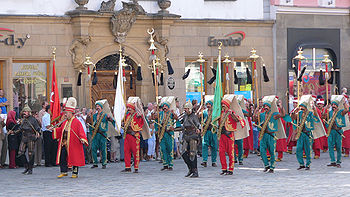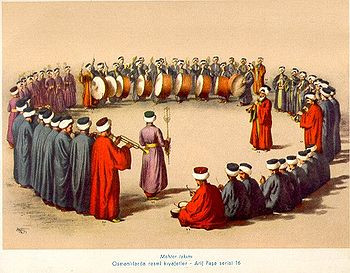- Ottoman military band
-
 A modern mehter marching band
A modern mehter marching band
Ottoman military bands are thought to be the oldest variety of military marching band in the world. Though they are often known by the Persian-derived word mahtar (مهتر; mehter in Ottoman Turkish) in the West, that word, properly speaking, refers only to a single musician in the band. In Ottoman, the band was generally known as mehterân (مهتران, from the Persian plural mahtarān), though those bands used in the retinue of a vizier or prince were generally known as mehterhane (مهترخانه, meaning roughly, "a gathering of mehters", from Persian "house of the mahtar"). In modern Turkish, the band as a whole is often termed mehter bölüğü ("mehter company [troop]"), mehter takımı ("mehter platoon"). In the West, the band's music is also often called Janissary music because the janissaries formed the core of the bands.
Contents
History
It is believed that individual instrumentalists may have been mentioned in the 8th century Orkhon inscriptions.[citation needed] Such military bands as the mehters, however, were not definitively mentioned until the 13th century[citation needed]. It is believed that the first "mehter" was sent to Osman I by the Seljuk Sultan Alaeddin Keykubad III as a present along with a letter that salutes the newly formed state. From then on every day after the afternoon prayer; "mehter" played for the Ottoman ruler. The notion of a military marching band, such as those in use even today, began to be borrowed from the Ottoman Empire in the 16th century. The sound associated with the mehterân also exercised an influence on European classical music, with composers such as Joseph Haydn, Wolfgang Amadeus Mozart, and Ludwig van Beethoven all writing compositions inspired by or designed to imitate the music of the mehters.
In 1826, the music of the mehters fell into disfavor following Sultan Mahmud II's massacre of the Janissary corps, who had formed the core of the bands. Subsequent to this, in the mid and late 19th century, the genre went into decline along with the Ottoman Empire. In 1911, as the empire was beginning to collapse, the director of Istanbul's military museum attempted a somewhat successful revival of the tradition, and by 1953—so as to celebrate the 500-year anniversary of the Fall of Constantinople to the forces of Sultan Mehmed II—the tradition had been fully restored as a band of the Turkish Armed Forces.
Today, the music of the mehters is largely ceremonial and considered by many Turks as a stirring example of heroism and a reminder of Turkey's historical past. Though the majority of the pieces performed by them are newer compositions.
Today, Mehter Troop (Mehter Bölüğü) is the band of the Turkish Armed Forces and it performs at the Military Museum (Askeri Müze) in Istanbul. See also: The Ministry of Culture Istanbul Historical Music Ensemble [1].
Structure
The standard instruments employed by a mehterân are the kös (a giant timpani), the nakare (a small kettledrum), the davul (a bass drum), the zil (cymbals), the kaba zurna (a bass variety of the zurna), the boru (a kind of trumpet), and the cevgen (a kind of stick bearing small concealed bells). The different varieties of bands are classed according to the number of instruments and musicians employed: either six-layered (altı katlı), seven-layered (yedi katlı), or nine-layered (dokuz katlı).
In the early 19th century the Vizier's personal band included nine each of drums and fifes, seven trumpets and four cymbals.[2]
The costumes worn by the mehterân, despite wide variance in color and style, are always very colourful, often including high ribbed hats which are flared at the top and long robes wrapped in colourful silks.
Members
Ceremonial Members:
Percussion Instruments:
-
Davul players
Wind Instruments:
-
Kaba zurna players
Style
The sound of the Ottoman military band is characterized by an often shrill sound combining bass drums, horns (boru), bells, the triangle and cymbals (zil), among others. It is still played at state, military and tourist functions in modern Turkey by the Mehter Band and the troops that accompany.
Mehterân usually play classical Turkish music such as peşrev, semai, nakış, cengiharbi, murabba and kalenderi. Most of the music played by mehterân is Turkish Folk Music with heroic themes from the Ottoman frontiers. Melodies and lyrics are written in Mehterhane (the house of Mehter).
The oldest extant marches were written by Nefiri Behram, Emir-i Hac, Hasan Can and Gazi Giray II in the 16th century. Though very few of these pieces are played today in Mehter groups.
Well-known composers
16th century 17th century 18th century - Nefiri Behram - Zurnazen Edirneli Daği Ahmed Çelebi - Hızır Ağa - Emir-i Hac - Zurnazenbaşı İbrahim Ağa - Hasan Can - Müstakim Ağa - Gazi Giray II. - Hammali Well-known compositions
Music of Turkey 
General topics - Ottoman military bands
- Whirling Dervishes
- Arabesque music
- European 'Turkish music' style
Genres Specific forms Ethnic music - Tenth year March
- Ottoman marches
Media and performance Music awards - Kral MV
- MÜ-YAP
- MGD
Music charts Billboard charts Music festivals Music media - Rolling Stone (Türkiye)
- MTV (Türkiye)
National anthem Independence March Regional music Local forms Ottoman regional styles "Ceddin Deden"
Though Mehter band played a variety of frontier marches, Ceddin deden is one of the best known
LyricsCeddin, deden, neslin, baban; x2
Hep kahraman Türk milleti.
Orduların, pek çok zaman, vermiştiler dünyaya şan. x2
Türk milleti!, Türk milleti!; x2
Aşk ile sev milliyeti,
Kahret vatan düşmanını, çeksin o mel'un zilleti. x2
which can be translated in English as:
(Seek) Your ancestors, your grandfathers, your generation, your father x2
The Turkish nation has always been valiant.
Your armies, many times, have been renowned throughout the world. x2
Turkish nation!, (O) Turkish nation!; x2
love (your) freedom passionately,
Overwhelm the enemies of your motherland, and thus shall those cursed ones suffer abjection. x2
"Yine de Şahlanıyor Aman"
Lyrics
Gene de şahlanıyor aman
Kolbaşının yandı da kır atı.
Görünüyor yandım aman
Bize serhad yolları.
Davullar çalsınlar aman
Aman da ceng-i ceng-i de harbiyi.
Görünüyor yandım aman
Bize sefer yolları.
Gâhi sefer olur aman
Aman da sefer sefer de eyleriz.
Hazan erişince aman
Aman güzel severiz.
Gül yüzlü yari de aman
Aman da hile ile de sezeriz.
Sefersiz olamaz aman
Aman er evlatları.
See also
Citations and notes
- ^ İstanbul Tarihi Türk Müziği Topluluğu * MEHTER BİRİMİ
- ^ p.267, Thornton
References
- Thornton, Thomas, The Present State of Turkey; Or,: A Description of the Political, Civil, and Religious, Constitution, Government, and Laws of the Ottoman Empire ... Together with the Geographical, Political, and Civil, State of the Principalities of Moldavia and Wallachia, Volume I, Printed for Joseph Mawman, London, 1809
External links
- The Ministry of Culture Istanbul Historical Music Ensemble
- Ottoman military band and Europe
- TheOttomans.org: entry on the Mehterhane
- Mehter marşlari (sound recording), Istanbul: Sera, 2001?, OCLC 50813631
Categories:- Turkish music
- Marching bands
- Military music
- Military units and formations of the Ottoman Empire
- Janissaries
Wikimedia Foundation. 2010.









